This was published 1 year ago
Main defence witness in trial of Michael and Lindy Chamberlain dies
BARRY BOETTCHER: 1934 - 2024
Barry Boettcher made a private visit to Mount Isa in 1984 in the aftermath of the Azaria Chamberlain case. The case had seen Pastor Michael Chamberlain and his wife Lindy convicted over the death of their daughter, Azaria, at Uluru in August 1980.
The convictions – Lindy for murder and Michael for being an accessory after the fact – had been upheld on appeal and the matter seemed settled. Except, of course, that it was not.
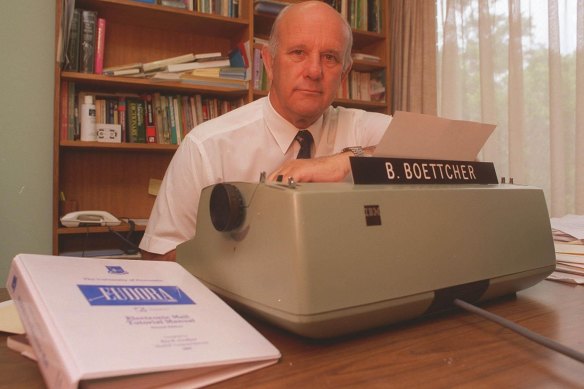
Barry Boettcher in 1996.Credit: Fairfax
Boettcher, retained by the defence, had argued in evidence that foetal haemoglobin could not have been identified in blood samples taken from the Chamberlain’s car. The Crown had argued that it could be, and that the blood had come from Azaria, and the jury had apparently sided with her.
Ultimately, that brought in the private trip to Mount Isa, where the Chamberlains had lived prior to their ill-fated trip to Uluru. At Mount Isa, Boettcher applied tests on various items, including his own motel wall, to see whether Ortho-tolidine, the re-agent used for to test for the presumptive presence of blood, could provide a positive result.
It did, and then the awful truth started to become apparent: that in all probability the re-agent being used in the Chamberlains’ car and on their possessions had indicated not the presence of blood at all, but of copper dust which was everywhere in Mount Isa and had affixed itself to sticky surfaces in the Chamberlains’ car. The supposed presence of blood had put the Chamberlains in the frame. The supposed identification of foetal haemoglobin had convicted them.
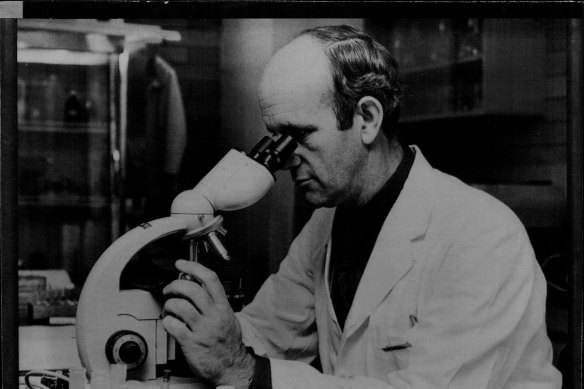
Boettcher in his laboratory in 1984.
The horrible truth was that there had never been any blood, and all the fuss and bother over the identification of foetal haemoglobin had been over something that did not exist. Of course, the Crown forensic biologist, Joy Kuhl, had not been able to detect the presence of foetal haemoglobin and Boettcher had said she could not.
But there was a lot more work to be done than merely incidental tests at Mount Isa to overturn the decisions of an eons-old system of justice that was meant to have had substantial safety mechanisms, or to sway the Northern Territory government and Crown who believed they had to make a stand against a mob outcry.
Boettcher and a handful of dedicated Chamberlain supporters nevertheless beavered away, going to the German company that had produced the reagent used by the Crown forensic biologist, Joy Kuhl. Boettcher took his case to his professional colleagues in the Australian Society of Immunologists. The world-renowned immunologist Sir Gustav Nossal was first to sign a letter endorsing Boettcher’s disquiet, followed by 30 other leading scientists.
The letter, publicised nationally, had a profound impact and added to the clamour which eventually forced the Northern Territory’s government’s hand in appointing a royal commission, leading to the exoneration of the Chamberlains. Boettcher, then professor of Biological Sciences at the University of Newcastle, had been unsuccessful in the witness box in the trial because his technical explanation went way over the heads of the jurors. In the aftermath of the conviction, some criticism was directed at him, but as Boettcher displayed throughout his life, you cannot keep a good man down.
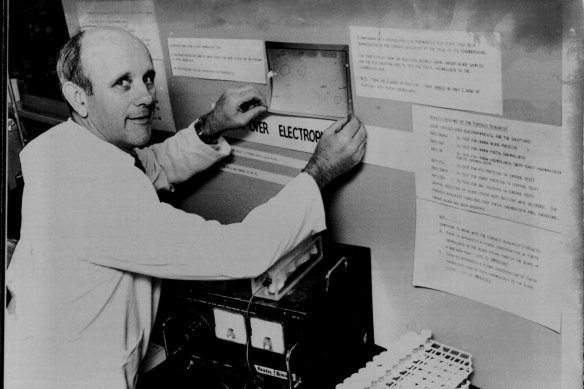
Boetcher of Newcastle University with display of his forensic work on the Chamberlin case in 1984.Credit: Fairfax
Boettcher was born in Tumby Bay, South Australia, on September 7, 1934, the second son of a pastrycook, Albert Boettcher and Ilma (née Haigh). It was Depression times and the family moved frequently so Albert could obtain work. They went to Berri, near the Murray River, Mildura and then Footscray.
Boettcher finished his schooling at Melbourne Boys’ High and though not matriculating, went to Melbourne Teachers’ College to become a primary school teacher. Adept at swimming and water polo, he started teaching in rural Victoria and at Tanybryn he met a trainee nurse, Moira Henriksen, whom he married in 1955. They set off for their honeymoon with Barry riding a motorbike and his bride in a sidecar.
Boettcher did a correspondence course to matriculate, travelling to Melbourne to do laboratory work in chemistry and physics, and got first class honours in both those subjects. He started a science degree at Adelaide University on an Education Department scholarship. Moira worked to provide extra money and Boettcher worked at weekends on such things as digging a pit for a septic tank and putting up fences.
Initially drawn to physics, he switched to genetics and biochemistry. Graduating, he got a job with the South Australian Department of Education. The first of four sons, Karl, was born in August 1962. In 1963, Boettcher accepted a scholarship to do a PhD degree at the University of Adelaide, selecting as his thesis: Genetic Control of Blood Group Substances in Body Secretions. Awarded his doctorate in 1966, he was now building an international reputation in blood groups, body secretions and reproduction.
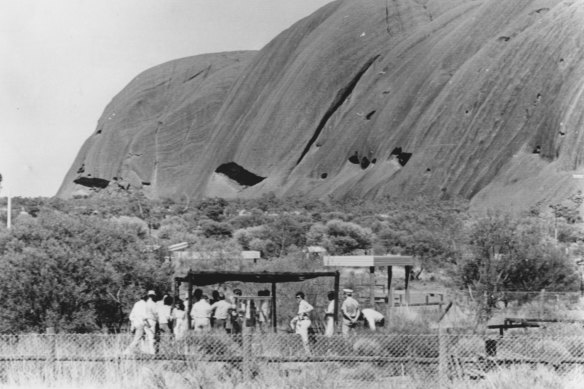
The 1981 Azaria Chamberlain inquest takes place under shade where the Chamberlains camped.Credit: Michael Rayner
Boettcher lectured at Flinders University and was invited to participate in the First International Symposium on Reproductive Immunology in Varna, Bulgaria, where he was elected as a councillor on the governing body. In 1967, an International Biological Programme was initiated to investigate effects of people adopting new and different diets. “This was based on the principle, notably proposed by Rev Thomas Malthus, that, as the population of the earth increases, it will outstrip the capacity of the earth to provide food,” Boettcher said. “I felt that [Indigenous Australians] ate a protein-rich diet and might not be able to readily adapt to a high carbohydrate, Western diet. I felt that I could do this as part of the study.”
As part of his research, he went with a team to the Northern Territory and camped at Uluru. Boettcher was made an honorary member of the Jungala group of the Warlpiri tribe. “In later years I collaborated in an international study of DNA sequences of Neanderthal origin,” Boettcher said. “[Aboriginal people] have a similar proportion of Neanderthal DNA sequences on the X chromosome as Caucasians. In other words, Aboriginal ancestors mixed with Neanderthals before migrating to Australia and New Guinea. We have common ancestry, along with all other humans, except the sub-Saharan Africans – who did not intermix with the Neanderthals. I wrote to the Yuendumu Council, relating this conclusion, pointing out that, since we have common ancestry, there is no scientific basis for racism in Australia.”
Boettcher and colleagues initiated the studies of white blood cell antigens, which has led to the capacity of providing kidney transplants to Aboriginal people needing them.
Boettcher attended a conference at Cambridge University organised by the Population Council, took up a Harkness Scholarship allowing him to travel to the United States and attended an international genetics conference in Tokyo, followed by a conference in Geneva on fertility control.
In Alaska, Boettcher visited a Naval Arctic Research Station where he took trips to collect blood and saliva samples from Inuit people, and continued his studies on starch digestion. In 1971, he took the position of foundation professor biological sciences at Newcastle University. After further overseas trips to Scandinavia and France, he was engaged by Stuart Tipple, the lawyer acting for Michael and Lindy Chamberlain, to give evidence on the identification of foetal haemoglobin on blood said to have been found in the Chamberlains’ car.
Ultimately vindicated, Boettcher went on to become an expert witness in many legal cases, usually as a defence witness, although twice he was a Crown witness, engaged by a former student who had become a policeman. He was involved in the inquiry into the conviction of Douglas Rendell, convicted of the murder. Boettcher gave critical evidence in the judicial inquiry into Rendell’s conviction, which exonerated Rendell.
Following the Chamberlains’ successful application to have their original convictions struck from the record, Boettcher then approached the NSW state member for Wallsend, John Mills, about having the conviction of a person quashed and removed from the record after it had been demonstrated that that person had been wrongly convicted. Mills introduced a private member’s bill to that effect and the bill succeeded.
Boettcher, who retired in December 1993, was made a member of the Order of Australia in 1998 for services to biological science and education and to reproductive immunology. The governor in presenting the award only commented on Boettcher’s contribution in the Chamberlain case.
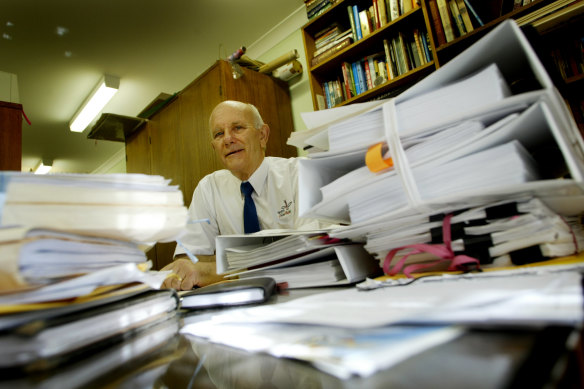
Barry Boettcher in 2004.Credit: Fairfax
Boettcher’s reputation as a defence expert led to his involvement in further court cases involving blood, secretions and DNA. These included the assistance to the lawyer for Bradley Murdoch, who had been accused of the murder of English tourist Peter Falconio in the Northern Territory. He presented reports to the Australian Academy of Forensic Science, including one on the Rendell case, where the scientific issues really disturbed him. Unsound procedures, he said, had been accepted by courts. He gave his final evidence in 2017 at the age of 82.
Barry Boettcher died in Newcastle on April 23. He is survived by his wife, Moira, sons Karl, Todd and Craig, daughter Kristine, eight grandchildren and two great-grandchildren.
Get the day’s breaking news, entertainment ideas and a long read to enjoy. Sign up to receive our Evening Edition newsletter.